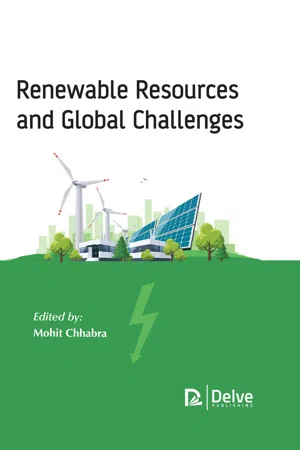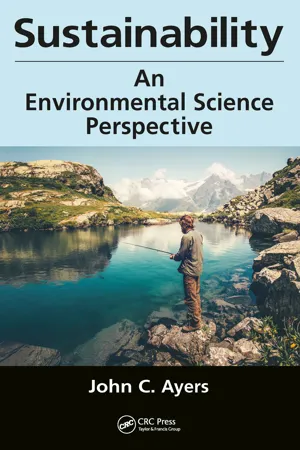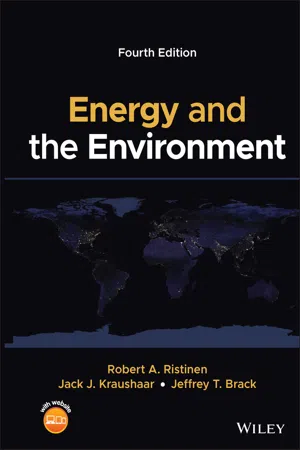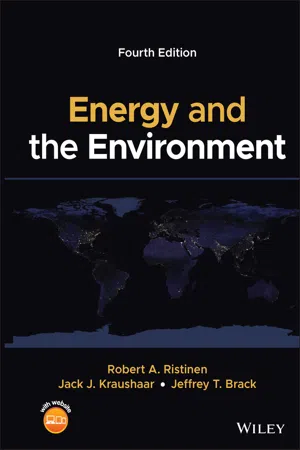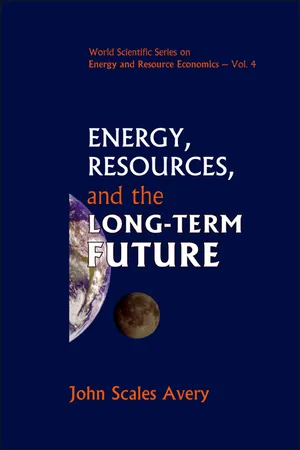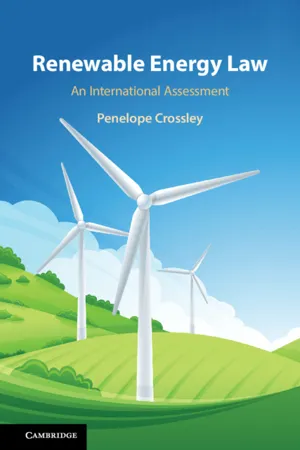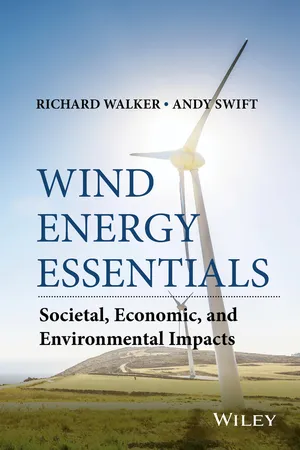Physics
Renewable Energy Sources
Renewable energy sources are natural resources that can be replenished over time, such as sunlight, wind, water, and geothermal heat. These sources are considered sustainable and environmentally friendly alternatives to non-renewable energy sources like fossil fuels. In physics, the study of renewable energy sources involves understanding the conversion of these natural resources into usable forms of energy.
Written by Perlego with AI-assistance
Related key terms
1 of 5
11 Key excerpts on "Renewable Energy Sources"
- eBook - PDF
- Mohit Chhabra(Author)
- 2019(Publication Date)
- Delve Publishing(Publisher)
1.1. INTRODUCTION Renewable sources of energy refer to the sources of those energies that are naturally acquired from the atmosphere and that are utilized from the sources that are naturally replenished and available. There are different types of Renewable Energy Sources such as solar energy, wind energy, geothermal energy, hydropower, and biomass. Figure 1.1: Representation of renewable sources of energy. Sources: https://cdn.pixabay.com/photo/2018/09/17/12/05/ener-gy-3683673_960_720.jpg, https://cdn.pixabay.com/photo/2017/04/01/15/05/ Introduction to Renewable Resources 3 big-waves-2193828_960_720.jpg, https://www.flickr.com/photos/ly-dur/4132279118, https://c.pxhere.com/photos/d0/41/wind_energy_renewable_ enegy_windmill_wind_mill_energy_rotation_power-993970.jpg!d, https://cdn. pixabay.com/photo/2017/07/11/08/33/dam-2492809_960_720.jpg Energy is something that is utilized everyday and is being used in day to day lives of people. The increase in science and technology and arrival of a number of novel inventions is leading to a number of gadgets and equipment that are put to use in everyday life. The increase in number of innovations that facilitate human beings lives everyday are known to demand and need enormous amounts of energy which is being used from fossil fuels. However, the use of a number of fossil fuels such as propane or electricity for lighting, heating, and powering of our devices is known to have created a huge amount of need for a variety of fossil fuels in large quantities because these are depleting non-renewable sources of energy. Therefore, to meet the demands of the energy requirement people started becoming more and more dependent on the renewable sources of energy that are freely available. There are a number of items such as computers, phone networks, servers, and security systems, shopping malls, parking lots, sports stadiums, cars, airplanes, and others which are increasing rapidly with the increase in technology. - eBook - ePub
- Milton W Cole, Angela D Lueking, David L Goodstein(Authors)
- 2018(Publication Date)
- WSPC(Publisher)
Chapter Thirteen
Renewable Energy Sources
“If we’ve learned any lessons during the past few decades, perhaps the most important is that preservation of our environment is not a partisan challenge; it’s common sense. Our physical health, our social happiness, and our economic well-being will be sustained only by all of us working in partnership as thoughtful, effective stewards of our natural resources.”Ronald Reagan1“The single greatest lesson the garden teaches is that our relationship to the planet need not be zero-sum, and that as long as the sun still shines and people still can plan and plant, think and do, we can, if we bother to try, find ways to provide for ourselves without diminishing the world.”Michael Pollan2“The next challenge we have to conquer is making sustainability more affordable — in other words, making it more sustainable.”Justin Johnson313.1Introduction to Renewable Energy Sources
The term “renewable energy” refers to those kinds of energy that are derived from sources that can be maintained over time without significant depletion of that energy source4 . The principal examples discussed below are hydroelectric energy, energy derived from wood and biomass, wind energy, geothermal energy, solar energy and tidal energy. This ordering reflects their historic relative importance in the U.S., although that order has been changing in recent years, as seen in Fig. 13.1 .Fig. 13.1 Annual renewable energy consumption in the United States, by source. One quadrillion BTU (one quad) = 1015 BTU ~ 8 × 1018 J = 8 exajoules. A quad is approximately equal to the energy expended by the country of Portugal in one year or the state of Virginia in 150 days. Data from the U.S. Energy Information Administration.Although solar energy is presented as its own category in these graphs, several other forms of renewable energy are indirectly created by the Sun. Solar radiation causes photosynthesis, which creates biomass, and evaporates water, which condenses later and so replenishes the streams and lakes responsible for hydroelectric power. Wind currents are caused by temperature variation on the ground, due to the uneven absorption of solar radiation by trees and bodies of water, as well as by the Earth’s rotation. Unlike many of the other renewable energies, geothermal energy is not driven by solar power; it utilizes the heat present naturally within the Earth due to radioactive decay, the slow densification of the Earth and the resulting friction between sub-surface rocks. Tidal energy results from the Earth’s rotation and the gravitational force of the Moon on our oceans. - eBook - PDF
Renewable Energy
Volumes 1 – 3
- Richard A Dunlap(Author)
- 2022(Publication Date)
- Springer(Publisher)
• Available power. All sources of energy are limited to some extent. The amount of power available from a given source will determine its maximum possible contribution to our total energy consumption. • Longevity. The length of time a resource will last depends on the total amount of en- ergy available. While we view renewable energy as renewable indefinitely, this may not always be the case. • Environmental impact. While renewable energy production may not directly produce CO 2 emissions, some may contribute to the greenhouse gas balance in the atmosphere as a result of geographical changes that produce greenhouse gases, such as methane, or reduce the natural sequestration of carbon dioxide. Other impacts may include effects on wildlife and direct or indirect effects on human health. 40 3. Renewable Energy Sources • Economics. The cost of Renewable Energy Sources is a factor in determining the time scale for their development. At present, fossil fuels are still plentiful and inexpensive. This fact motivates their continued use and may delay the development of potentially viable, but more expensive, renewable sources. Additional factors that may influence the development of certain Renewable Energy Sources include social perception, political agendas, security, and safety. There are a number of options for carbon-free energy and the present chapter concentrates on the five that have made the greatest contribution thus far to carbon-free energy production and are likely to continue to do so in the foreseeable future. These energy sources are: hydroelectric, solar, wind, geothermal, and biofuels. Several other approaches to renewable energy are in the early stages of development and may make important contributions to our energy needs at some point in the future. These approaches include: tidal energy, wave energy, ocean thermal energy conversion, and osmotic energy. For the present discussion, nuclear energy is not considered renewable. - eBook - ePub
Sustainability
An Environmental Science Perspective
- John C. Ayers(Author)
- 2017(Publication Date)
- CRC Press(Publisher)
10 Renewable Energy SourcesIn a sense, the fossil fuels are a one-time gift that lifted us up from subsistence agriculture and should eventually lead us to a future based on renewable resources. Kenneth Deffeyes 2001We cannot create or destroy energy, we can only capture it. The sun provides, either directly or indirectly, nearly all of the energy available to us. Plants capture solar energy directly through photosynthesis. Fossil fuels contain the energy of sunlight captured directly by plants millions of years ago. Photovoltaic (PV) cells also capture sunlight energy directly. Other energy sources capture the energy of sunlight indirectly. Energy from the sun powers the flow of air and water. We usually capture the kinetic energy of wind and water by using a turbine that transfers the energy to an alternator , an electrical generator that produces alternating current.In this chapter we will see that renewable wind, water, and sun energy sources are sustainable because they are renewable, clean, safe, and nearly carbon-free. Although they have low energy densities, meaning that they require larger areas of land or water than nonRenewable Energy Sources to produce a fixed amount of energy, they are sufficient to meet the energy needs of most countries. Perhaps the greatest challenge facing humanity is to transition to renewable energy as rapidly as possible to mitigate global climate change.Sunlight and wind are public goods because they have low excludability and low subtractability, meaning they are freely available to everyone (Section 5.4.3 ). This is fortunate, as other sources of energy such as fossil fuels have often been monopolized by the wealthy and powerful to further their wealth and power. Even the poor can afford to use solar cooking, passive solar heating, and biofuels, and as prices for PV panels continue to decrease they are becoming increasingly common in poor villages.As we saw in Chapter 9 - eBook - PDF
- Robert A. Ristinen, Jack J. Kraushaar, Jeffrey T. Brack(Authors)
- 2022(Publication Date)
- Wiley(Publisher)
5 Renewable Energy Sources II Alternatives Russell Illi g /Gett y Ima g es, Inc. 5.1 Introduction Solar energy can fulfill our energy needs in many wondrous ways. Aside from the direct uses of solar radiation covered in the last chapter, there are also the less direct technologies of hydroelectricity, wind energy, biomass, ocean thermal gradients, ocean currents, and ocean waves for making use of energy from the sun. In addition to using the energy sources of solar origin, we have also learned how to exploit ocean tides and geothermal resources. These are all Renewable Energy Sources that can be explored to see what potential they have for provid-ing useful amounts of energy in an economically and environmentally sound way. The over-all flow of energy to and from the earth is shown in Figure 5.1. 125 Energy and the Environment , Fourth Edition. Robert A. Ristinen, Jack J. Kraushaar, and Jeffrey T. Brack. © 2022 John Wiley & Sons, Inc. Published 2022 by John Wiley & Sons, Inc. Companion website: www.wiley.com/go/brack/energyandenvironment4thedition 5.2 Hydropower Hydroelectricity is a well-established technology; it dates back to the beginnings of the elec-tric power industry more than 100 years ago. About 7% of the electric power now generated in the United States comes from our damming the rivers as they flow to the ocean and then releasing the water to turn turbines connected to electric generators. The use of water power is much greater in some other countries; Norway obtains 99% of its electricity from water power, Nepal 95%, Brazil 93%, New Zealand 78%, Canada 58%, and Sweden 50% (half hydro, half nuclear). Hydropower was important long before electricity generation became possible. About 2000 years ago, during the first century BCE, it was discovered that the force of moving water acting on a waterwheel could be used to ease human labor. - eBook - ePub
- Robert A. Ristinen, Jack J. Kraushaar, Jeffrey T. Brack(Authors)
- 2022(Publication Date)
- Wiley(Publisher)
5 Renewable Energy Sources II : Alternatives5.1 Introduction
Solar energy can fulfill our energy needs in many wondrous ways. Aside from the direct uses of solar radiation covered in the last chapter, there are also the less direct technologies of hydroelectricity, wind energy, biomass, ocean thermal gradients, ocean currents, and ocean waves for making use of energy from the sun. In addition to using the energy sources of solar origin, we have also learned how to exploit ocean tides and geothermal resources. These are all Renewable Energy Sources that can be explored to see what potential they have for providing useful amounts of energy in an economically and environmentally sound way. The overall flow of energy to and from the earth is shown in Figure 5.1 .Natural energy flow (in units of power) to and from the earth.Figure 5.1Source: M. K. Hubbert (1972). “Man's Conquest of Energy: Its Ecological and Human Consequences,”. In: The Environmental and Ecological Forum 1971–1972. Washington, DC: U.S. Atomic Energy Commission Publication TID‐258575.2 Hydropower
Hydroelectricity is a well‐established technology; it dates back to the beginnings of the electric power industry more than 100 years ago. About 7% of the electric power now generated in the United States comes from our damming the rivers as they flow to the ocean and then releasing the water to turn turbines connected to electric generators. The use of water power is much greater in some other countries; Norway obtains 99% of its electricity from water power, Nepal 95%, Brazil 93%, New Zealand 78%, Canada 58%, and Sweden 50% (half hydro, half nuclear).Hydropower was important long before electricity generation became possible. About 2000 years ago, during the first century BCE, it was discovered that the force of moving water acting on a waterwheel could be used to ease human labor. Various types of ingeniously contrived waterwheel mechanisms were connected by rotating shafts and cogwheels to mills for grinding grain and sawing wood. By the thirteenth century, water power was used to operate hammers in the ironworks of Western Europe, and by the sixteenth century, the waterwheel was the primary source of industrial power in that part of the world. The steam engine eventually replaced water power in many applications, but in selected locations and for certain purposes, water power continued to be the preferred energy source. As our nation developed, mills were established at sites with reliable water flow of sufficient volume and velocity. Communities then grew up around these mills. Dams were built at many such sites to impound the flowing water and to even out the flow over the seasons. After electricity came into practical use, waterwheels were used to drive generators; it then became reasonable to locate hydroelectric plants at a distance from population centers and to transport the electricity over power lines hundreds of miles to the point of demand. Now, we use water power almost exclusively for the generation of electricity, even if there is only a modest distance between the point of generation and the point of use. - eBook - PDF
Our Energy Future
Introduction to Renewable Energy and Biofuels
- Carla S. Jones, Stephen P. Mayfield(Authors)
- 2016(Publication Date)
- University of California Press(Publisher)
STUDY QUESTIONS 1. Define renewable and sustainable. Explain why fossil fuels are neither renewable nor sustain-able. Is nuclear energy renewable and sustain-able? Why or why not? Give some examples of truly renewable and sustainable energy resources. 2. Briefly explain the importance of the design of the nuclear reactor in the use of nuclear fission reactions for the production of electricity. 3. Briefly describe the energy resources that we can utilize from each of the primary energy sources. How can these resources be utilized best in society (electricity, transportation, etc.)? 4. Explain the three main types of solar power generation and how they differ in using the sun’s energy to generate power. 5. Briefly discuss how water on the planet can be used to generate energy. 6. Explain why renewable energy technologies do not play a more dominant role in global energy consumption. 7. Explain why biofuels may have a different niche in the renewable energy future than many of the other renewable resources. those gallons can come from corn ethanol, while the rest must come from non-corn ethanol-based sources (EPA, 2014). This chapter has given you an overview of the various forms of renewable energy resources available on the planet. The latter parts of this book will focus exclusively on the various biomass sources for the production of biofu-els and their commercialization. Because the production of biomass will result from agricultural processes developed over thousands of years, it is important to have a basic understanding of how the use of industrial agricultural knowledge can help both maintain a robust food supply and expand the opportunity to use plants and algae as a source of biofuels. Accordingly, the next chapter will intro-duce the fundamentals of industrial agriculture. This page intentionally left blank - eBook - PDF
- John Scales Avery(Author)
- 2007(Publication Date)
- World Scientific(Publisher)
When biogas has been sufficiently cleaned so that it can be distributed in a pipeline, it is known as “renewable natural gas”. It may then be distributed in the natural gas grid, or it can be compressed and used in internal combustion engines. Renewable natural gas can also be used in fuel cells, as will be discussed below in the section on Hydrogen Technology. 8.3 Solar energy Biomass, wind energy, hydropower and wave power derive their energy indirectly from the sun, but in addition, various methods are available for utilizing the power of sunlight directly. These include photovoltaic panels, solar designs in architecture, solar systems for heating water and cooking, concentrating photovoltaic systems, and solar thermal power plants. Photovoltaic cells and concentrating photovoltaic systems Solar photovoltaic cells are thin coated wafers of a semiconducting mate-rial (usually silicon). The coatings on the two sides are respectively charge donors and charge acceptors. Cells of this type are capable of trapping so-lar energy and converting it into direct-current electricity. The electricity generated in this way can be used directly (as it is, for example, in pocket 134 ENERGY, RESOURCES AND THE LONG-TERM FUTURE calculators) or it can be fed into a general power grid. Alternatively it can be used to split water into hydrogen and oxygen. The gases can then be compressed and stored, or exported for later use in fuel cells. In the future, we may see solar photovoltaic arrays in sun-rich desert areas pro-ducing hydrogen as an export product. As their petroleum reserves become exhausted, the countries of the Middle East and Africa may be able to shift to this new technology and still remain energy exporters. The cost of manufacturing photovoltaic cells is currently falling at the rate of 3%-5% per year. - No longer available |Learn more
- (Author)
- 2014(Publication Date)
- Academic Studio(Publisher)
Most of earth's available energy resources are renewable resources. Renewable resources account for more than 93 percent of total U.S. energy reserves. Annual renewable resources were multiplied times thirty years for comparison with non-renewable resources. In other words, if all non-renewable resources were uniformly exhausted in 30 years, they would only account for 7 percent of available resources each year, if all available renewable resources were developed. Solar energy Renewable Energy Sources are even larger than the traditional fossil fuels and in theory can easily supply the world's energy needs. 89 PW of solar power falls on the planet's surface. While it is not possible to capture all, or even most, of this energy, capturing less than 0.02% would be enough to meet the current energy needs. Barriers to further solar generation include the high price of making solar cells and reliance on weather patterns to generate electricity. Also, current solar generation does not produce electricity at night, which is a particular problem in high northern and southern latitude countries; energy demand is highest in winter, while availability of solar energy is lowest. This could be overcome by buying power from countries closer to the equator during winter months, and may also be addressed with technological developments like Infrared Solar Panel systems which can capture energy in cloudy conditions and even at night. Globally, solar generation is the fastest growing source of energy, seeing an annual average growth of 35% over the past few years. Japan, Europe, China, U.S. and India are the major growing investors in solar energy. Wind power The available wind energy estimates range from 300 TW to 870 TW. Using the lower estimate, just 5% of the available wind energy would supply the current worldwide energy needs. Most of this wind energy is available over the open ocean. The oceans - eBook - PDF
Renewable Energy Law
An International Assessment
- Penelope Crossley(Author)
- 2019(Publication Date)
- Cambridge University Press(Publisher)
132 Andrii Gritsevskyi, Renewable vs. Non-Renewable Energy Sources, Forms and Technologies (UN Statistical Commission, unknown) 5–6. 133 Kammen, above n 68, 404. 40 The Renewable Energy Sources Used for Electricity Generation submerged, 134 displacing an estimated 1.3 million people. 135 This displace- ment has dislocated the local population from their traditional homes and land, often removing them from subsistence agriculture and separating local communities. This is a problem that is often inadequately addressed. 2.5.2.3 Natural Constraints on the Growth of Large-Scale Hydropower The third reason why large-scale hydropower projects are controversial is that due to their scale, there are often natural constraints on the construction of new dams. That is, there needs to be natural water flows from higher points of elevation to lower levels of elevation, as well as land that can be viably flooded and contained in impoundment dams. This means that large-scale hydropower projects are not ‘renewable’ unless there are the right environmental conditions. 2.5.2.4 The Super Profits and Additionality Problems Hydropower is already one of the cheapest forms of energy available due to its long infrastructure life compared with other energy projects, and low main- tenance costs. 136 Further, due to its historical development largely occurring in the immediate pre- and post-World War II period, the hydropower sector has already benefited from extensive public subsidies. 137 To incorporate hydropower into the definition of ‘renewable energy’ adopted by the primary legislative instruments in each of the jurisdictions studied would perversely provide the owners of hydropower projects with super profits. - eBook - ePub
Wind Energy Essentials
Societal, Economic, and Environmental Impacts
- Richard P. Walker, Andrew Swift(Authors)
- 2015(Publication Date)
- Wiley(Publisher)
13 NON-WIND Renewable Energy Sources USED TO MEET ELECTRICITY NEEDS13.1 COMPARING SOURCES OF ELECTRIC GENERATION: ATTRIBUTES THAT WILL BE CONSIDERED
All sources of electric generation have positive attributes and negative attributes, and they all seem to have both supporters and detractors. In the following two chapters, we will discuss Renewable Energy Sources (other than wind energy) used for electricity generation and nonrenewable sources of electric generation. Factors relevant to environmental and economic impacts will be considered in hopes of presenting an “apples-to-apples” comparison. The various facts, factors, impacts, and/or issues that will be evaluated include the following:- Installed capacity and net generation in the United States/average capacity factors
- Basics of the technology/efficiency
- Primary operational mode within the electric grid
- Capital cost/variable costs including fuel/levelized cost of energy
- Availability of fuel source and price variability
- Emissions/effect on human health
- Production of solid and/or hazardous wastes and disposal options
- Cooling water requirements/other water requirements
- Impacts to surface water and groundwater quality
- Land use requirements/compatibility with other uses
- Workforce health and safety
13.2 RENEWABLE ENERGY GENERATION RESOURCES IN THE UNITED STATES
The U.S. Energy Information Administration compiles data regarding electricity generation, as well as other types of energy use such as transportation fuels, in their Annual Energy Review [1]. Table 13.1
Index pages curate the most relevant extracts from our library of academic textbooks. They’ve been created using an in-house natural language model (NLM), each adding context and meaning to key research topics.
